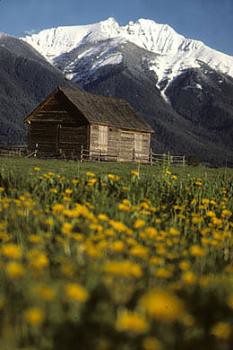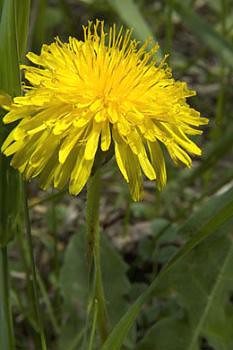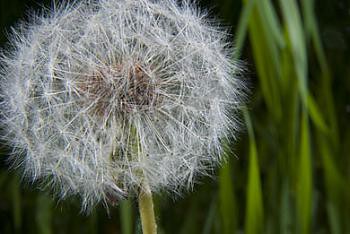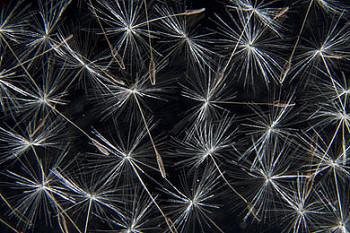In Defense of Dandelions

Dandelions, Fort Connah
©Bert Gildart: I doubt whether one of our farming friends realizes the impact of his comments, but few have prompted a greater response than one he made the other day.
“Bert,” he said, “it looks like you’re cultivating dandelions.”
The comment prompted me to run into town on Saturday and purchase several bags of Weed and Feed, as well as the very best ($35.99) cart for dispersing the stuff. Next day, I awoke early and peered out over my lawn. The sun was just peeking over the nearby mountain range, and, lo, it appeared as though I might not need the chemicals. Satisfied, I eased back to the kitchen to make coffee.
Half an hour later, I returned to my deck and what a transformation. Our lawn was now a spotted field of yellow heads interspersed with familiar globular seed heads. The transformation prompted me to dig out a botany book, informing me that the flowers are light dependent, blooming when the sun shines, but closing with the advent of fog, clouds and rain.
That information then propelled a series of responses to include a backyard photo expedition, an experiment with various dandelion dinning concoctions, a random seed count, and a rush to brew dandelion beer and wine. From previous outings, I knew dandelions can add color to photographs, such as the image of Fort Connah, an old historic trading post back dropped by the Mission Mountains. Though the old stucture is about 50 miles to our south, there’s every reason to believe seeds from this field have found there way to our yard. With their built-in parachutes, that ain’t nuthin’ for a dandeline.
Sunday, however, I added to that appreciation, learning that dandelions are one of the most ubiquitous plant species known to man. Though some books say they were first introduced from Europe into Minnesota, other books say they have inhabited both the old world and the new world since time immemorial. They derive their name, however, from an Old French word Dent-de-lion, which means “lions tooth.” Look at the lance shaped leaf and you can easily see why.

Dandelion Blossom
As I read more about the species, I wanted to see firsthand some of the features described in my botany book. And, so, with trowel in hand (fertilizer now completely forgotten), I began wandering about my field, digging here and there, for I was intent on an experiment that was part culinary.
Long I have known that dandelions are edible—just not the extent. Textual descriptions, however, say the benefits from eating the plant are innumerable, and can benefit the liver, kidneys, and stomach. Certainly, that’s a good reason to fill your yard with dandelions—and explore their epicurean delights.
Specifically, you can slice the taproot, cook it and eat it as a vegetable, or you can incorporate it into a soup. Leaves are easier to work with, though they, too, can be boiled as a dish or incorporated into a salad.
So, too, the yellow flowers, but they are also an excellent source for dandelion wines, something Janie and I know about from a business trip we made several years ago to a Hutterite community in eastern Montana. We had spent several days with the colony’s residents and become friends with several families. As time went by, at the end of each day, we found on the seat of our truck a bottle of dandelion wine. Ingredients, they said, included three quarts of dandelion flowers, raisins, a gallon of water, sugar, lemons, orange and yeast.
Perhaps it was all these memories coming together with the profusion of dandelions growing in our yard that helped motivate my day’s research. Continuing my digging, I discovered it was easy with a trowel to gather the parts under consideration, for indeed the yard appeared to be a cultivated field. In short order I amassed roots, leaves and yellow flowers.

Each globe yields about 200 seeds
Returning to the house, my first thought was to count the number of seeds in the familiar globe, which I accomplished using a set of tweezers. I found my random sample yielded 126. I then took about a dozen of the seeds (they look like miniature parachutes), arranged them on a clean glass, and with two strobe lights placed behind the seeds, photographed them.
I continued reading and learned that seed numbers per globe can vary from 54 to 172 seeds—and that a single plant can produce 2000 seeds a year, and that a dense stand of dandelions (such as our one-acre yard), can produce about 39,271,255 seeds a year.
Hey, this is fascinating stuff!
Returning to the leaves, I then began preparing a salad, something we do each day. However, I substituted the dandelion leaves for lettuce. To this I added the normal ingredients and doused it all with olive oil and a splash of vinegar. The combination was delicious, and though we thought dandelion leaves to be slightly bitter, we read that if we harvest after the flowers have dropped, the bitterness is reduced. Now we want to see what the results of my first winery will produce, but the results require six months of fermentation.
Before closing, here are a few other interesting facts about dandelions, focusing mostly on the root: Dandelion root is a registered drug in Canada, sold as a diuretic. Many use the milky latex from the root as a mosquito repellent. As well, the “milk” is applied to warts and a mixture of roasted roots is sold as a coffee known as DandyBlend.
Though there’s much more, I close with a fact that should interest my son-in-law, defensive about his home state. Each year Minneapolis, Minnesota, celebrates Dandelion Days, started apparently by a lady from Maine who is said to have introduced them, as she missed their brilliant color.

"Parachute" adds to seed’s mobility
For me the celebration is sufficient justification to forget about the Weed and Feed and let the darn things grow. Expect another report in about six months, when the wine we’re making has properly aged. But be forewarned; I might get carried away then…


May 21st, 2007 at 12:46 pm
I fight with them in my lawn also, to a much lesser degree. A mispronunciation that I made has renamed them in my family. They are ‘damndelions’. I don’t always have time to remove the actual plant so every day before and after work, I make sure that I pick off any yellow flowers or buds that I see. I figure that if I can’t actually remove the plant, I can limit it spread of seeds.
May 28th, 2007 at 8:17 pm
THANK YOU FOR THE DANDELION INFO-I LOVED THE FIGURES AND THE PICTURES. BY THE WAY, HOW IS JANIE DOING?
July 6th, 2008 at 9:31 pm
If anyone has seen the commercial where the Indian guy sheds a tear as he sees someone littering. Thats me (crying) when I see a Scotts fertalizer commercial trying to “control” (kill) my most favorite spring time tasty meal.
If anyone wants a GREAT salad dressing recipe for the GREAT DANDELION or (Italian word) CICCOTIA (Phonetically pronounced) chi-gott-e-ah salad please e-mail me tmacaroni@yahoo.com
YUMMY…
Ciao!
January 5th, 2009 at 3:58 pm
Thank you for this article!
I love that little weed!
May 21st, 2012 at 5:20 pm
I REALLY ENJOYED YOUR THIS ARTICAL. I’VE BEEN EATING THEM ALL MY LIFE. THERE ARE SO MANY KIND, DIFFERENT TEXTURES BUT IF YOU DON’T LIKE THEM BITTER PICK THEM EARLY SPRING. SO MANY WAYS TO PREPARE IT AND GOOD FOR THE BLOOD TOO! THANK YOU MUCH.